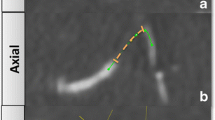Abstract
Purpose: Our aim was to evaluate the usefulness of MRI and MRA in patients with cerebrovascular disease.
Patients and Methods: MRI and MRA (TOF and contrast enhanced [CE]) were performed in 28 patients with acute and subacute stroke. Images were reviewed retrospectively and the modalities compared with ultrasound, CT and DSA. DSA was performed in two patients, ultrasound in eleven patients and CT in 17 patients.
Results: MR and MRA were sufficient in 27 of 28 patients (96%). In eleven patients (39%) the CE-MRA was superior to TOF-MRA. In only two patients (8%) TOF-MRA lead to further information. Even when TOF-MRA is needed complete examination time is much shorter than using CT and ultrasound or DSA. Doppler sonography revealed correct diagnosis in eight of eleven patients (72%).
Conclusion: In 93% of the stroke patients a complete MR-based diagnostic work-up can be achieved within 3-minute scan time and approximately 5-minute reevaluation time without any invasive techniques or radiation.
Zusammenfassung
Ziel: Zweck der Studie war, den diagnostischen Wert von konventionellem MRT und MRA bei Patienten mit zerebrovaskulären Erkrankungen zu evaluieren.
Patienten und Methoden: Mittels MRT und MRA (TOF und kontraverstärkt [CE]) wurden 28 Patienten mit akutem und subakutem Schlaganfall untersucht. Die Bilder wurden retrospektiv ausgewertet und die Untersuchungsmodalitäten und Befunde mit denen von Ultraschall, CT und DAS verglichen. Zwei Patienten wurden mit der DSA, elf mit Doppler-Ultraschall und 17 mittels CT untersucht.
Ergebnisse: MRT und MRA wurden für eine umfassende Diagnostik bei 27 von 28 Patienten (96%) als vollständig und ausreichend bewertet. Bei elf Patienten (39%) war die CE-MRA der TOF-MRA in der Diagnostik überlegen. Bei nur zwei Patienten (8%) erbrachte die TOF-MRA zusätzliche Informationen. Selbst wenn zusätzlich die TOF-MRA durchgeführt wird, ist eine vollständige Untersuchung in einer kurzen Zeitspanne möglich, die deutlich unter der Untersuchungszeit für CT-, Ultraschall- oder DSA-Untersuchungen liegt. Doppler- Ultraschall führte in acht von elf Patienten (72%) zu einer korrekten und vollständigen Diagnose.
Schlussfolgerung: In 93% der Schlaganfallpatienten ist eine vollständige Diagnostik mittels MR in 3 Minuten Untersuchungszeit und etwa 5 Minuten Nachverarbeitungszeit ohne invasive Techniken oder Röntgenstrahlung möglich.
Similar content being viewed by others
Author information
Authors and Affiliations
Additional information
Received: September 18, 2002; accepted: October 6, 2002
Correspondence Address Elke R. Gizewski, MD, Department of Neuroradiology, University of Essen, Hufelandstraße 55, 45127 Essen, Germany, Phone (+49/201) 723-1539, Fax -5959, e-mail: elke.gizewski@uni-essen.de
Rights and permissions
About this article
Cite this article
Gizewski, E., Forsting, M. One-Stop Shopping MRI in Cerebrovascular Disease: Extravagance or Up-to-Date?. Klinische Neuroradiolgie 12, 168–173 (2002). https://doi.org/10.1007/s00062-002-3338-2
Issue Date:
DOI: https://doi.org/10.1007/s00062-002-3338-2




